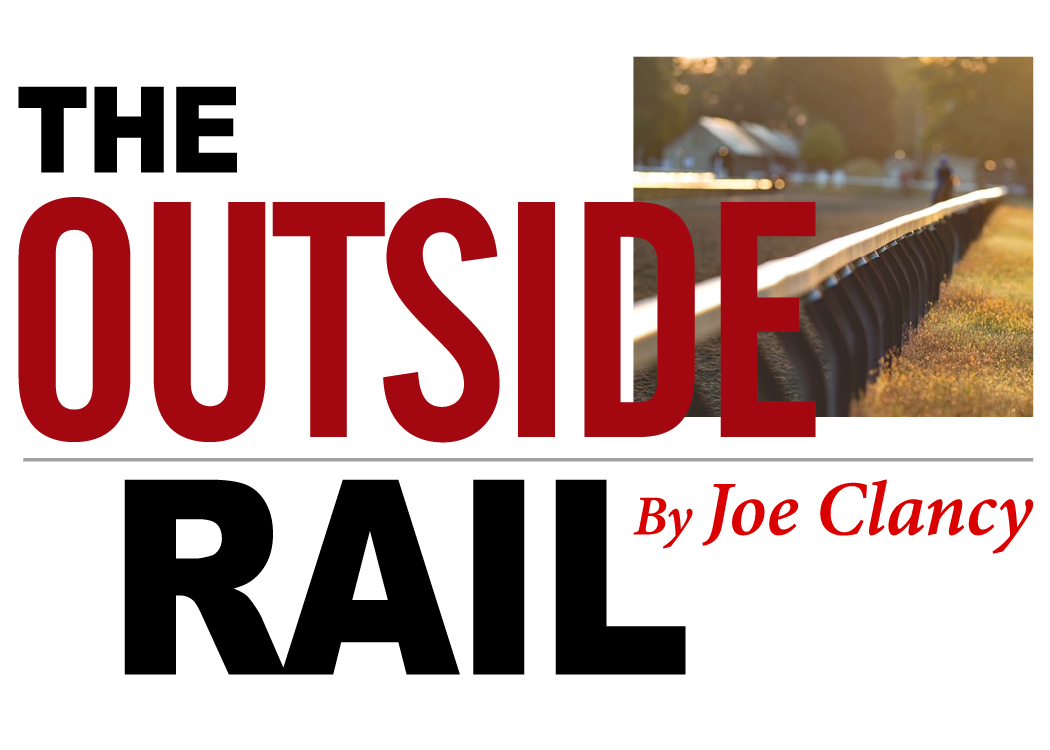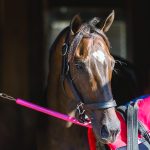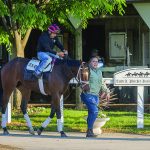I’m glad there was no hidden camera in the barn when I got in the fight with the King’s Bishop colt at Delaware Park all those years ago. He nearly killed me, and I broke the handle of a pitchfork when I hit him across the back. I’m sure I swore at him. Sorry. And he barely flinched.
I’m glad there was no hidden camera in the barn when Fourmatt, the best horse in the stable, fell off the treadmill and rolled out the barn door. I probably swore. He was fine, but it was terrifying. I’m really glad there was no hidden camera the day the same horse bled from the nose while turned out in a round pen. That’s when I knew, for sure, he’d never be a racehorse again.
I’m glad there was no hidden camera in the paddock when I fell off stud colt Money By Orleans while jogging in a straw ring on a bone-rattling cold morning in Pennsylvania. He ran around loose trying to mount Rollicking Run, a filly on the same winter jogging set. I know I swore, once I got up off the ground.
I’m glad there was no hidden camera in the barn when I tried to put a saddle on the unbroken 2-year-old I thought was the new 3-year-old one winter. I’m glad there was no hidden camera in the barn when I stuck a safety pin through the bandage and into Spring In Athens’ leg. He bled, a little, but he was OK.
I’m really glad there was no hidden camera on the racetrack at Delaware Park when the horse I was galloping broadsided a loose one running the wrong direction up the stretch. My horse was a 17-hand gelding by Best Turn so he pretty much just shook off the crash and kept going. I have no idea what happened to the other one.
I’m also glad there was no camera to see the life draining from the trembling, dreadfully sick lead pony on another day in another barn at Fair Hill. I patted him on the face and talked to him while holding his halter so the vet could give him a shot. He was too sick, we couldn’t figure out why and there were too many horses to protect from whatever he had. It all happened quickly, quietly, peacefully. I cried a little. The horse dropped to the ground. I took off his halter and told him everything was going to be all right.
If you work with horses, closely and for long, you like them. You aren’t an animal abuser. You appreciate horses’ innocence, their fragility, their mortality. But you also manage what you do. They can hurt you and themselves if you’re not careful. They can be afraid of things less than half their size. They can be difficult to figure out. Some come with hidden self-destruct buttons. Ultimately, you’re responsible and that’s the hardest part. Just as ultimately, somebody else is frequently calling the shots and all you can do is the best you can. But at it’s core, it’s very core, any animal sport must take care of the animals to the best of its ability. Racing can never be made 100-percent safe. There will always be risk and racing will always have to work to manage that risk.
We published a position statement or treatise or whatever you want to call it about the state of racing this week. We think things should change. We think the old days are over. We think it’s a crisis (of public opinion and perception more than of horse welfare, but the results are the same). We think the industry is in danger. It’ll never go away or die, but it will also never be settled if it can’t come to grips with the responsibility needed to steward the raising and training of animals to run at high speeds in public in a modern world.
Things to think about:
– Thoroughbred racehorses are athletes, not pets. They’re going to get hurt, they’re going to need medicine, treatment, supplements, remedies, surgeries, diagnoses, veterinarians. To think otherwise is foolish.
– People are going to push the envelope. It’s a race, not a pretty horse contest. The horses train, get fit, compete. There’s money on the line. People invest, get paid, work to be better than the next guy.
– All horses would do better with more down time. Run them when and where you want, but find ways to send them to the farm, to give them some rest, to let them be horses in a field somewhere. I love to see the Eastern turf horses coming back in the spring off five-month layoffs. Ben’s Cat and Wise Dan take extended breaks every year – even if there are opportunities elsewhere. Obviously, horses of that quality are easier to rest than others but the point is still the same. No other sport’s season lasts all year. Racing never stops.
– Reach out to other nations that race. Ask for help. Copy them. Hong Kong, England, Ireland, France, Australia. The uninformed say horses in those countries train and race medication free. Obviously they don’t. They do have tighter controls than the United States and do a far better job of keeping out race-day medications and punishing rule-breakers. Other nations have better rules, clearer procedures, harsher penalties and – for whatever reason – more finality to it all. In the United States, it seems like a suspension is merely an opportunity to appeal. A ban should be a ban. Other countries have the advantage of one governing body. But they aren’t without problems. They just seem better equipped to deal with problems. The British Horseracing Authority website has a Frequently Asked Questions section about medication and doping control – with 47 questions and answers about withdrawal times, prohibited substances, supplements, herbal products, pre-race testing, steroids and so on.
– Much of what was on the PETA video is perfectly legal and benign. A horse was being examined with an endoscope. It might look bad, but it’s a diagnostic tool (the same type of tool used in humans). Other video clips showed horses’ joints being injected. While awful if overused, the treatment can relieve pain, decrease swelling, avoid surgery and return horses to productive racing careers. Good stewards of the horse use such remedies with caution and care. The audio of the blacksmith talking about a lack of a pulse in a horse’s foot? That’s a good thing. You don’t want to feel a pulse in a horse’s foot.
– Training operations are too big. I realize this is America, the land of opportunity and capitalism and free enterprise and Amazon and Wal-Mart and server farms and Exxon merging with Mobil but there’s something to be said for encouraging smaller training stables. One trainer with hundreds of horses and multiple divisions teeters on the edge of reducing horses to numbers, statistics, commodities. And that looks bad to outsiders.
– Owners play a key role. You can speak volumes by choosing a trainer. Try a young person. Think about a smaller outfit. Think twice about a barn with a history of medication violations. Ask questions. Demand answers. Get detailed veterinary reports about your horses. Ask more questions. Don’t choose a trainer solely because of his or her winning percentage or superb use of speed figures as race-placement tools. Choose a trainer who cares for horses, honorably, and then let that trainer do his or her job.
– Invest in better advocates for the horse. Owners, trainers, assistants, jockeys, officials, veterinarians, anyone with a license ought to go through some training on what to say and how to say it – to the media, to the public, to newcomers (especially) – when it comes to horse safety, care and welfare.
– It’s not really about Lasix. Powerful owners and breeders say they want Lasix use stopped now. Horsemen’s groups disagree with some national medication reform because it calls for the end of race-day Lasix use. Get over yourselves, everybody. Nothing can be done until all races in the country are conducted under the same rules, so get that figured out first. Then worry about Lasix.
– The synthetic surface issue is a puzzle. It’s obviously a safer thing for horses to run on and plenty of trainers swear by it. It’s also different and people are intimidated or something. American racing over-reacted and installed too many without enough research. Now American racing appears to be over-reacting again and taking them out. The Breeders’ Cup is being short-sighted by basically requiring all potential host sites to be dirt-based only. What’s wrong with a synthetic-track hosting periodically? Not a thing. The world is small and the world is oriented toward turf and synthetic surfaces. Only here do we say dirt is where horses are supposed to race.
– The #fullstory campaign should continue, unofficially, and should have started years ago. It should also change to #fullstoryracehorses. Why keep playing to PETA? Leave out the agendas, just show racehorses getting some love or living the good life.






